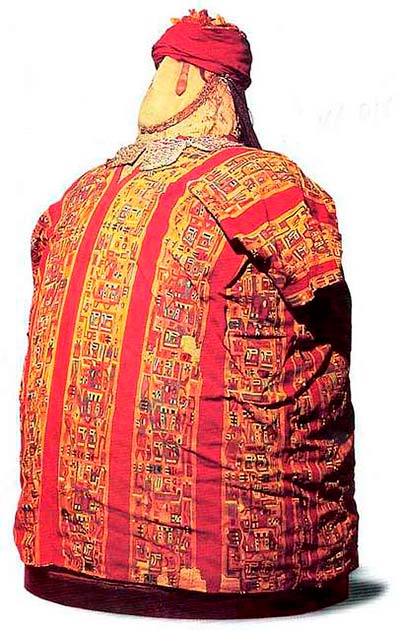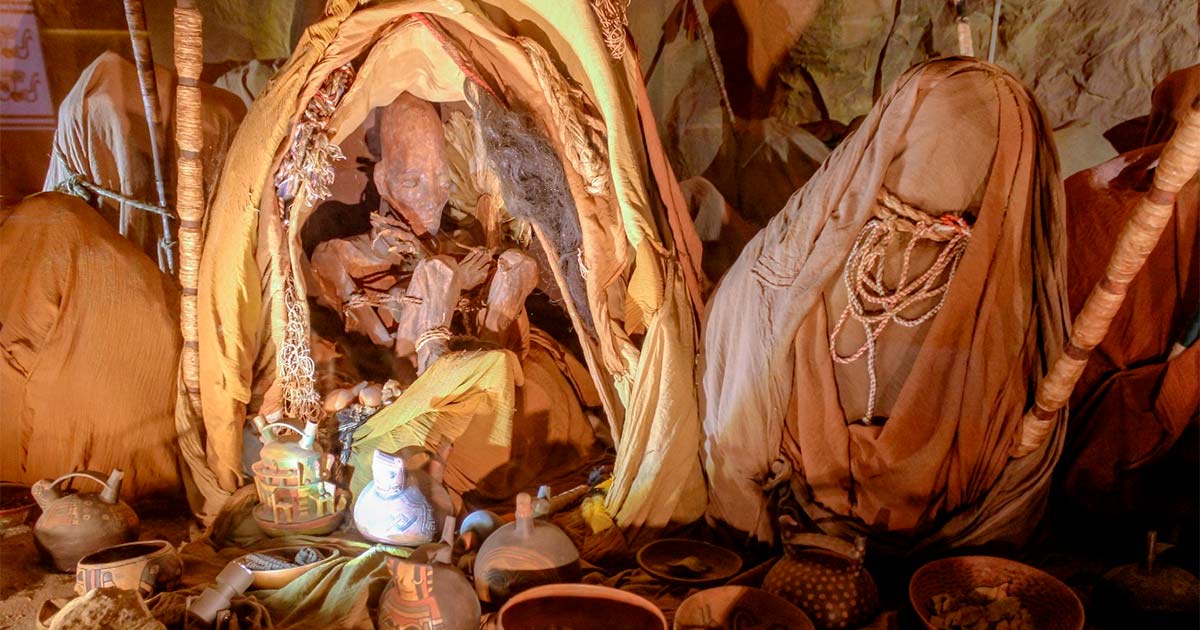Burial Bundles with Painted Bodies in Fabric Found in Peru Pyramid
Archaeologists in Peru have uncovered a monumental temple site where they discovered unique human burials wrapped in fabrics printed with bizarre zoomorphic designs. These bundles contain the remains of deceased individuals, as well as various offerings and personal belongings wrapped in multiple layers of textiles, often with intricate designs and patterns. Found in tombs and caves, many burial bundles have been preserved for hundreds, or even thousands of years.
High Status Ancient Burials
PAP reports that within one burial mounds, archaeologists identified the wrapped remains of a young boy whose skull was “intentionally deformed.” Wrapped in a three meters (9.84 ft) long cloth which was decorated with “totally unique zoomorphic representations,” the researchers reported that the boy was born into a “high-status family.”
Cranial deformation was a common practice in Peru. The process involved binding the heads of infants to create a flattened or elongated skull, often with the intention of denoting social status or cultural affiliation.
Łukasz Majchrzak is a bioarchaeologist focused on pre-Columbian cultures in Peru, specializing in health, diet, and lifestyle. Majchrzak, said the boy’s wraps were covered with “unique” zoomorphic representations, and similar fabrics have never been found anywhere in the Andes mountains to date.

Dyed fabric found in a tomb at the top of the site, dated 772 -989 AD Photo: Łukasz Majchrzak
Painted And Wrapped for The Afterlife
The team of archaeologists were excavating what they describe as “a monumental temple” on the Cerro Colorado hill located near the city of Barranca in Peru, when they found the series of “unique tombs.” These were not ordinary burials because the people within the graves were painted and wrapped in high-quality fabrics.
Located near the coastal city of Barranca in Peru, Cerro Colorado is a famously red hill which is caused by high levels of iron oxide in the soil. With expansive panoramic views of the surrounding landscape, including the Pacific Ocean and the Andes Mountains, this important archaeological site features a sunken plaza and an amphitheatre, which were utilized in the pre-Columbian era.
The recent excavations were conducted by a team of archaeologists from the Jagiellonian University and St Mark’s University, in the “Los valles de Barranca” project. According to a report on Nauka W Polsce, four earthen mounds were excavated in 2022 and, amidst a monumental temple structure, four tombs were discovered containing painted human remains wrapped in high-quality fabrics that dated to 772 AD - 989 AD.
- Mummified Head of Newborn Baby with Extremely Elongated Skull Found in Peru
- Wari Culture Used Alcohol and Drugs to Maintain Political Control

Cross-section of a Peruvian mummy bundle. Source: Juulijs / Adobe Stock
Unwrapping Ancient Burial Bundles
The above dating determined that the graves belonged to the Wari culture, whose legacy can be found at Castillo de Huarmey, located only 70 kilometres (43.5 miles) north of Barranca in the Huarmey district of Peru. Castillo de Huarmey is a 16th-century coastal fortress built by Spanish conquistador Francisco Pizarro's brother-in-law, Jerónimo de Aliaga. The castle is known for its unique blend of Spanish, Inca, and Chimú architectural styles and contains numerous well-preserved murals depicting daily life in the region, and a Wari mausoleum.
On two of the newly excavated pyramidal mounds, the monumental temple was found to have been constructed using dried red clay bricks and stone blocks. This discovery inspired a large-scale excavation of the site which revealed the burial bundles, also known as "fardos funerarios".

An example of a Wari burial bundle (Public Domain)
Revitalizing Ancient Holy Sites
Research revealed that while the burials dated to between 772 AD and 989 AD, the temple complex itself was built between 2500 and 2200 BC. This dating is derived from two of the four structures, with the remaining two not yet excavated, so the site might prove to be even older.
Majchrzak explained that such settlements, with “imposing architecture,” were built in the Andes during the third millennium BC. As agriculture spread, as a result of increasing interactions with communities residing in the Amazon, later Andean cultures established burial necropolises in abandoned deeply-ancient places of worship, believing their ancestors were buried within the timeworn pyramids.
Top image: Peruvian mummy bundles, representational. Source: Bayamin / Adobe Stock.
By Ashley Cowie




















Comments
A bit more information on this research from:
https://www.researchgate.net/publication/346616149_RADIOCARBON_DATING_OF...
Following are two notable exerpts from the above: “No matter whether buried in a “modest”,“standard”,or “elaborate” bundle, all remains of people who died older than 25 years had stress markers that clearly suggested the execution of physical work.” And, “The samples were usually taken from the cotton layers that separated the textiles of the bundle, or the corn cobs put between them. In all cases we chose material placed within an undisturbed stratigraphic position, in order to eliminate the possibility of influence by external factors. In five cases (CF 38, 18, 11, 33, and CF 41), the vegetal material decomposed, so the sample was taken from the hair of the individuals. These samples are not considered in further discussion, due to lack of the 15N and 13C measurements, and possible reservoir effect.”
Two things to note: One, the evidence DOES NOT suggest the typical knee-jerk notion of ‘elite status’ for the dead, despite any wares that may have been found with them. And two, for the ONLY hair samples tested, they cite the ‘reservoir effect’, which is often conveniently used (and typical) to explain away carbon-dating that turns out MUCH older than the prevailing narratives can explain.
So, is the science here, get in the way of the 'art of lying', or does it debunk the false narrative?
Nobody gets paid to tell the truth.